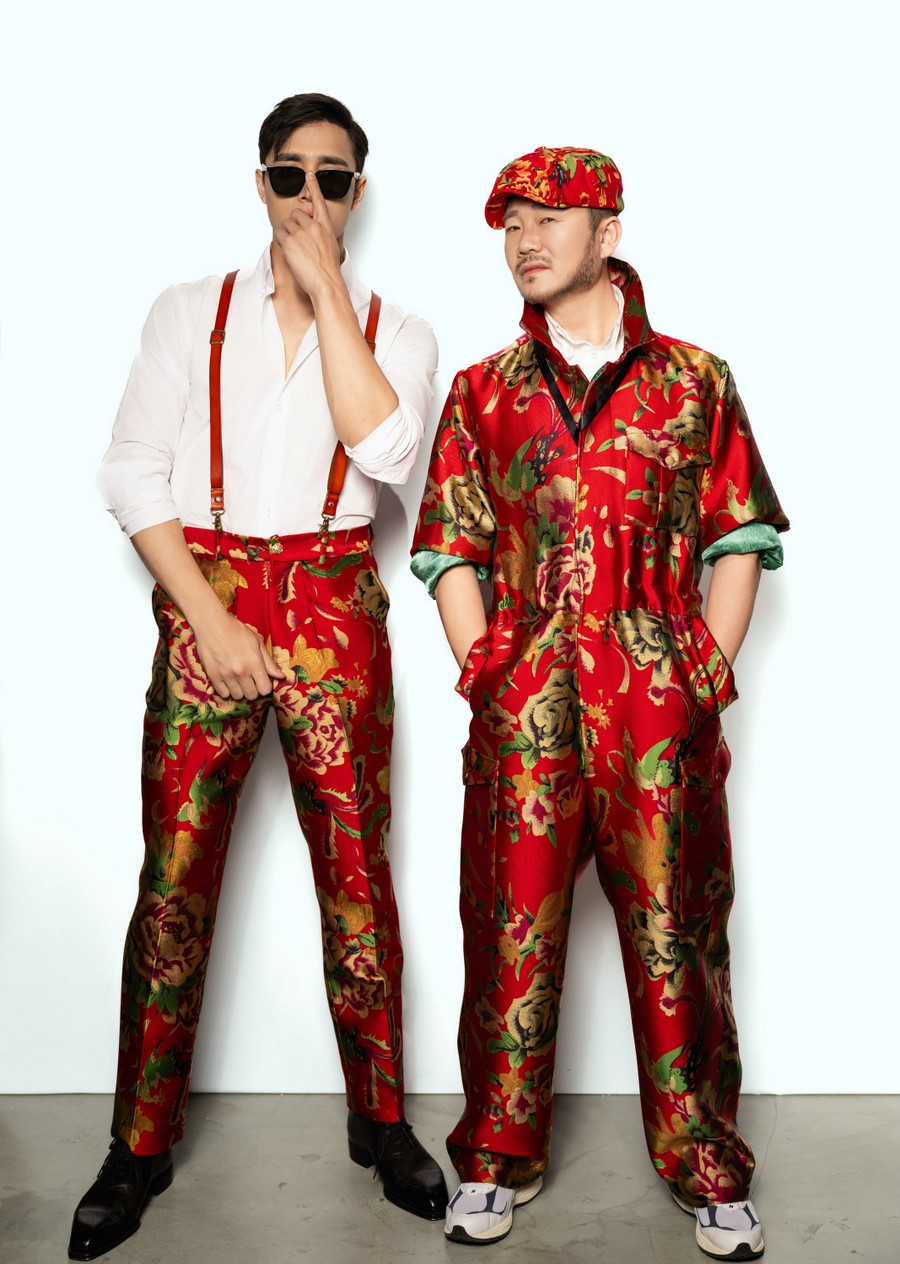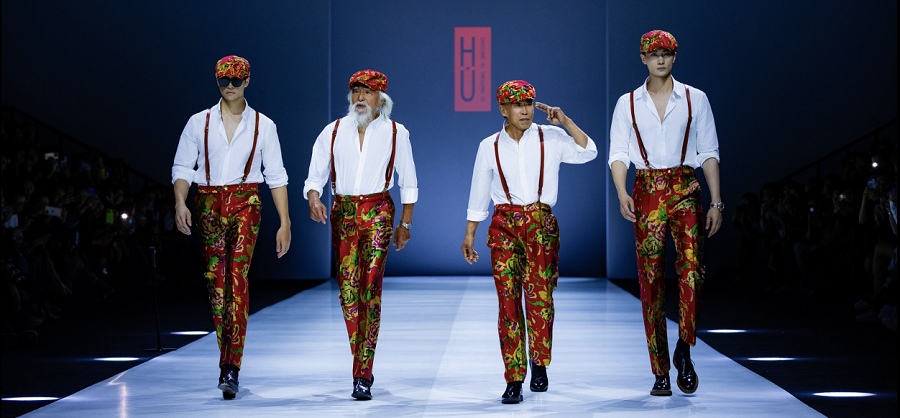ANN/CHINA DAILY – On Douyin, the Chinese counterpart of TikTok, the feeds of many have been graced by the captivating stride of influencer Li Meiyue. Sporting bespoke suits adorned with the distinctive “Northeast China big flower” print, Li has taken the streets of global fashion hubs like New York, Paris, London, and Tokyo by storm.
With each viral video amassing tens of millions of likes, Li’s magnetic presence has transcended cultural boundaries, turning heads and garnering admiration from diverse audiences worldwide.

At the 2024 A/W Shanghai Fashion Week, designer Hu Sheguang, the creative force behind Li’s iconic suits, unveiled his latest haute couture collection titled “Power of Time—Dongbei Dahua by the Bund.”
This collection, exclusively showcasing the once-controversial pattern, made its debut at the BUND Space on Saturday, captivating attendees with its unique blend of tradition and innovation.
Li, sporting his iconic suit on the catwalk, mesmerised the audience and turned the show into a carnival celebrating the enduring power and beauty of dongbei dahua.
All made with jacquard fabric with a soft sheen, the new collection comprises three-piece suits, windbreakers, cloaks, qipao dresses and the Chinese style men’s standing-collar long coats.
Presenting the garments were Yu Weiwei, Miss World China in 2013, and 34 of Hu Sheguang’s Supermodels, a team of fashion enthusiasts with an average age of 55.
The highlight of the show came when Wang Deshun, an 88-year-old model and actor, strutted the catwalk.
Dressed in a shirtless clean-cut suit, the shapely octogenarian quietly flaunted his chest, radiating the same confidence and charisma when he first modelled for Hu during the 2015 Beijing Fashion Week.
The then 79-year-old Wang, only fitted with padded cotton pants with a touch of dongbei dahua decorations, walked bare-chested on the runway. His topless look made a sensation on the Internet and earned him the nickname “Hottest Grandpa”.

The Shanghai fashion show reminded many of the chequered history of dongbei dahua.
According to Hu, the origin of the floral print can be found in the traditional Chinese pattern yi nian jing, literally meaning “the scenery of a year”, featuring representative flowers of the four seasons including the peach blossom, the lotus flower, the chrysanthemum, the peony and the plum blossom. Used in fabrics, lacquerware, ceramics and jewellery, the print flourished during the Song dynasty (960-1279).
In the 1950s and 60s, designers at the East China Textile Management Bureau in Shanghai borrowed inspiration from the traditional pattern and created the dongbei dahua prototype featuring blossoming peonies and the phoenix. Cotton cloth with the floral print has since become a popular choice for blanket covers and bed sheets in Northern China, especially in rural areas.
The print gained more traction in Northeast China, where local people regarded the floral pattern as auspicious and being able to ward off evil; the vibrant print could also offer some contrast to balance out the drabness of the region’s long, cold winter.
Actors of Errenzhuan (a two-person folk performance of comedy, dance and song popular in Northeast China) became ambassadors of this print as they were often seen clothed from head to toe of this psychedelic print, which was gradually dubbed dongbei dahua.
Because of its long-standing association with rural China and errenzhuan, which used to be scorned by the cultured for its dirty jokes, dongbei dahua was for a long time associated with plebeian or even vulgar tastes.
That explains why in 2014 when the maverick designer transformed the ubiquitous print from his childhood memories into his first dongbei dahua-themed collection Dahuaao (big flower cotton-padded jacket), he was met with criticism and doubt.
That also explains why Chinese actress Zhang Xinyu’s debut look at the Cannes Film Festival in 2015 attracted polarising comments. She was clad in a dongbei dahua dress elaborately designed by Hu which accentuated her hour-glass figure. Some people commended her and the designer for promoting Chinese aesthetics on a global stage, while most others ridiculed her look as attention-seeking and embarrassing.

Why has public opinion made a U-turn on the floral print over the last decade?
Experts say that dongbei dahua designs have found increasing resonance with modern urbanites because they could easily evoke collective memories in which the print was popular in large swaths of China.
The popularity of dongbei dahua has also coincided with the rise of guochao, a consumption trend wherein younger consumers prefer products with Chinese cultural elements. The print is viewed as one of the visual symbols from China’s recent history.
In addition, rock music has also helped alter the stereotypical perception of the flamboyant print in youth culture.
Second Hand Rose, a popular rock band hailing from Northeast China, is known for incorporating folk culture, especially Errenzhuan, with rock music. Dongbei dahua is featured heavily in the band’s album designs and merchandise. Band members also often perform in costumes made of the floral print, inspiring fans to follow suit and see the print as cool and non-conformist.
“I held the show in Shanghai because dongbei dahua was born here and I want to re-define it as a classical pattern in fashion,” Hu told reporters during an interview after the release.
“As many brands are characterised by a certain colour or style, I think dongbei dahua is the same to me,” said the designer, adding that he aspires to influence a generation of people with this pattern and help it go global as a culture.
Hu has been studying traditional Chinese patterns. “The royal patterns housed in the Palace Museum, and those in paper cuts, Batik, shadow plays and ancient architecture, are all our precious cultural heritage worth researching and revitalising through fashion,” he remarked.
“Heritage can only be truly passed down when it becomes a part of people’s daily lives. This is not only the goal of cultural inheritance efforts but also a mission of mine as a fashion designer.”







